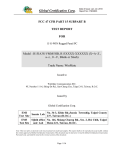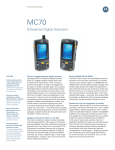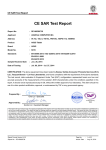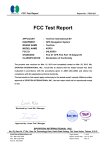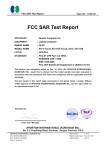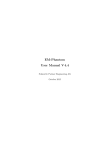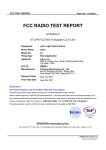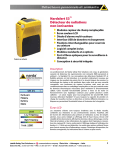Download CE SAR Test Report
Transcript
Report No. : EA332116-01 CE SAR Test Report CE SAR Test Report APPLICANT : TomTom International BV EQUIPMENT : GPS Navigation System BRAND NAME : TomTom MODEL NAME : 4FA50,4FL50 STANDARD : EN 62311:2008 EN 62209-2:2010 EN 62479:2010 ARPANSA RPS3:2002 AS/NZS 2772.2:2011 The product was completely tested on Jun. 19, 2013. We, SPORTON INTERNATIONAL INC., would like to declare that the tested sample has been evaluated in accordance with the procedures and shown the compliance with the applicable technical standards. The test results in this report apply exclusively to the tested model / sample. Without written approval of SPORTON INTERNATIONAL INC., the test report shall not be reproduced except in full. Reviewed by: Eric Huang / Deputy Manager Approved by: Jones Tsai / Manager SPORTON INTERNATIONAL INC. No. 52, Hwa Ya 1st Rd., Hwa Ya Technology Park, Kwei-Shan Hsiang, Tao Yuan Hsien, Taiwan, R.O.C. SPORTON INTERNATIONAL INC. TEL : 886-3-327-3456 FAX : 886-3-328-4978 Page Number : 1 of 31 Report Issued Date : Jun. 28, 2013 Report Version : Rev. 01 Report No. : EA332116-01 CE SAR Test Report Table of Contents 1. Statement of Compliance ............................................................................................................................................. 4 2. Administration Data ...................................................................................................................................................... 5 2.1 Testing Laboratory ................................................................................................................................................... 5 2.2 Applicant.................................................................................................................................................................. 5 2.3 Manufacturer ........................................................................................................................................................... 5 2.4 Application Details ................................................................................................................................................... 5 3. General Information ...................................................................................................................................................... 6 3.1 Description of Equipment Under Test (EUT)............................................................................................................ 6 3.2 Applied Standards ................................................................................................................................................... 7 3.3 Device Category and SAR Limits ............................................................................................................................ 7 3.4 Test Conditions ........................................................................................................................................................ 7 4. Specific Absorption Rate (SAR) ................................................................................................................................... 8 4.1 Introduction ............................................................................................................................................................. 8 4.2 SAR Definition ......................................................................................................................................................... 8 5. SAR Measurement System ........................................................................................................................................... 9 5.1 E-Field Probe .........................................................................................................................................................10 5.2 Data Acquisition Electronics (DAE) ........................................................................................................................10 5.3 Robot...................................................................................................................................................................... 11 5.4 Measurement Server .............................................................................................................................................. 11 5.5 Phantom .................................................................................................................................................................12 5.6 Device Holder .........................................................................................................................................................13 5.7 Data Storage and Evaluation .................................................................................................................................14 5.8 Test Equipment List ................................................................................................................................................16 6. Tissue Simulating Liquids ...........................................................................................................................................17 7. System Verification Procedures .................................................................................................................................19 7.1 Purpose of System Performance check .................................................................................................................19 7.2 System Setup .........................................................................................................................................................19 7.3 SAR System Verification Results............................................................................................................................20 8. EUT Testing Position ...................................................................................................................................................21 9. Measurement Procedures ...........................................................................................................................................22 9.1 Spatial Peak SAR Evaluation .................................................................................................................................22 9.2 Power Reference Measurement .............................................................................................................................23 9.3 Area & Zoom Scan Procedures ..............................................................................................................................23 9.4 Volume Scan Procedures .......................................................................................................................................24 9.5 SAR Averaged Methods .........................................................................................................................................24 9.6 Power Drift Monitoring ............................................................................................................................................24 10. Conducted Power (Unit: dBm) ..................................................................................................................................25 11. Antenna Location .......................................................................................................................................................26 12. SAR Test Results .......................................................................................................................................................27 12.1 Test Records for Body SAR Test ..........................................................................................................................27 13. Simultaneous Transmission Analysis ......................................................................................................................28 14. Uncertainty Assessment ...........................................................................................................................................29 15. References ..................................................................................................................................................................31 Appendix A. Plots of System Performance Check Appendix B. Plots of SAR Measurement Appendix C. DASY Calibration Certificate Appendix D. Test Setup Photos SPORTON INTERNATIONAL INC. TEL : 886-3-327-3456 FAX : 886-3-328-4978 Page Number : 2 of 31 Report Issued Date : Jun. 28, 2013 Report Version : Rev. 01 Report No. : EA332116-01 CE SAR Test Report Revision History REPORT NO. VERSION EA332116-01 Rev. 01 SPORTON INTERNATIONAL INC. TEL : 886-3-327-3456 FAX : 886-3-328-4978 DESCRIPTION Initial issue of report ISSUED DATE Jun. 28, 2013 Page Number : 3 of 31 Report Issued Date : Jun. 28, 2013 Report Version : Rev. 01 Report No. : EA332116-01 CE SAR Test Report 1. Statement of Compliance The maximum results of Specific Absorption Rate (SAR) found during testing for TomTom International BV GPS Navigation System, 4FL50 , are as follows. <Highest SAR Summary> Exposure Position Frequency Band 10g-SAR (W/kg) GSM900 1.450 GSM1800 0.584 Body (0.5cm Gap) Highest 10g-SAR (W/kg) 1.450 This device is in compliance with Specific Absorption Rate (SAR) for general population/uncontrolled exposure (Localized 10-gram SAR for trunk, limit: 2.0W/kg) specified in Council Recommendation 1999/519/EC, and ICNIRP Guidelines, and R&TTE Directive - 1999/5/EC, and ARPANSA Standard RPS3 and had been tested in accordance with the measurement methods and procedures specified in EN 62311:2008, EN 62479:2010, and EN 62209-2:2010, and AS/NZS 2772.2:2011. SPORTON INTERNATIONAL INC. TEL : 886-3-327-3456 FAX : 886-3-328-4978 Page Number : 4 of 31 Report Issued Date : Jun. 28, 2013 Report Version : Rev. 01 Report No. : EA332116-01 CE SAR Test Report 2. Administration Data 2.1 Testing Laboratory Test Site SPORTON INTERNATIONAL INC. Test Site Location No. 52, Hwa Ya 1 Rd., Hwa Ya Technology Park, Kwei-Shan Hsiang, Tao Yuan Hsien, Taiwan, R.O.C. TEL: +886-3-327-3456 FAX: +886-3-328-4978 st 2.2 Applicant Company Name TomTom International BV Address Rembrandtplein 35 1017 CT Amsterdam The Netherlands 2.3 Manufacturer Company Name Tech-Giant (Shanghai) Computer Co., Ltd Address C#, No. 1, South Rongteng Road, Songjiang Export Processing Zone, Shanghai, China 2.4 Application Details Date of Start during the Test Jun. 19, 2013 Date of End during the Test Jun. 19, 2013 SPORTON INTERNATIONAL INC. TEL : 886-3-327-3456 FAX : 886-3-328-4978 Page Number : 5 of 31 Report Issued Date : Jun. 28, 2013 Report Version : Rev. 01 Report No. : EA332116-01 CE SAR Test Report 3. General Information 3.1 Description of Equipment Under Test (EUT) Product Feature & Specification EUT GPS Navigation System Brand Name TomTom Model Name 4FA50,4FL50 S/N QH1113G00063 Wireless Technology and GSM900: 880.2 MHz ~ 914.8 MHz Frequency Range GSM1800: 1710.2 MHz ~ 1784.8 MHz Bluetooth: 2402 MHz ~ 2480 MHz Mode •GPRS •Bluetooth 2.1 + EDR WWAN: FPC Antenna Antenna Type Bluetooth: Ground chip HW Version 1.0 SW Version 1.0 Transfer Mode Category Class C – EUT can only support Packet Switched service. EUT Stage Production Unit Remark: 1. The above EUT's information was declared by manufacturer. Please refer to the specifications or user's manual for more detailed description. 2. Voice call is not supported. 3. This device supports GPRS up to multi-slot class 10 4. Model names 4FL50 support GPRS function where 4FA50 does not. SPORTON INTERNATIONAL INC. TEL : 886-3-327-3456 FAX : 886-3-328-4978 Page Number : 6 of 31 Report Issued Date : Jun. 28, 2013 Report Version : Rev. 01 CE SAR Test Report Report No. : EA332116-01 3.2 Applied Standards The Specific Absorption Rate (SAR) testing specification, method and procedure for this device is in accordance with the following standards: ‧ Council Recommendation 1999/519/EC ‧ EN 62311: 2008 ‧ EN 62209-2: 2010 ‧ EN 62479: 2010 ‧ ARPANSA RPS3:2002 ‧ AS/NZS 2772.2:2011 3.3 Device Category and SAR Limits This device belongs to portable device category because its radiating structure is allowed to be used within 20 centimeters of the body of the user. Limit for General Population/Uncontrolled exposure should be applied for this device, it is 2.0 W/kg as averaged over any 10 gram of tissue. 3.4 Test Conditions 3.4.1 Ambient Condition Ambient Temperature Humidity 20 to 24 ℃ < 60 % 3.4.2 Test Configuration The device was controlled by using a base station emulator. Communication between the device and the emulator was established by air link. The distance between the EUT and the antenna of the emulator is larger than 50 cm and the output power radiated from the emulator antenna is at least 30 dB smaller than the output power of EUT. The EUT was set from the emulator to radiate maximum output power during all tests. SPORTON INTERNATIONAL INC. TEL : 886-3-327-3456 FAX : 886-3-328-4978 Page Number : 7 of 31 Report Issued Date : Jun. 28, 2013 Report Version : Rev. 01 Report No. : EA332116-01 CE SAR Test Report 4. Specific Absorption Rate (SAR) 4.1 Introduction SAR is related to the rate at which energy is absorbed per unit mass in an object exposed to a radio field. The SAR distribution in a biological body is complicated and is usually carried out by experimental techniques or numerical modeling. The standard recommends limits for two tiers of groups, occupational/controlled and general population/uncontrolled, based on a person’s awareness and ability to exercise control over his or her exposure. In general, occupational/controlled exposure limits are higher than the limits for general population/uncontrolled. 4.2 SAR Definition The SAR definition is the time derivative (rate) of the incremental energy (dW) absorbed by (dissipated in) an incremental mass (dm) contained in a volume element (dv) of a given density (ρ). The equation description is as below: 𝐒𝐀𝐑 = 𝐝 𝐝𝐖 𝐝 𝐝𝐖 ( )= ( ) 𝐝𝐭 𝐝𝐦 𝐝𝐭 𝛒𝐝𝐯 SAR is expressed in units of Watts per kilogram (W/kg) SAR measurement can be either related to the temperature elevation in tissue by 𝐒𝐀𝐑 = 𝐂 ( 𝛅𝐓 ) 𝛅𝐭 Where: C is the specific head capacity, δT is the temperature rise and δt is the exposure duration, or related to the electrical field in the tissue by 𝐒𝐀𝐑 = 𝛔|𝐄|𝟐 𝛒 Where: σ is the conductivity of the tissue, ρ is the mass density of the tissue and E is the RMS electrical field strength. However for evaluating SAR of low power transmitter, electrical field measurement is typically applied. SPORTON INTERNATIONAL INC. TEL : 886-3-327-3456 FAX : 886-3-328-4978 Page Number : 8 of 31 Report Issued Date : Jun. 28, 2013 Report Version : Rev. 01 Report No. : EA332116-01 CE SAR Test Report 5. SAR Measurement System Fig 5.1 SPEAG DASY System Configurations The DASY system for performance compliance tests is illustrated above graphically. This system consists of the following items: A standard high precision 6-axis robot with controller, a teach pendant and software A data acquisition electronic (DAE) attached to the robot arm extension A dosimetric probe equipped with an optical surface detector system The electro-optical converter (EOC) performs the conversion between optical and electrical signals A measurement server performs the time critical tasks such as signal filtering, control of the robot operation and fast movement interrupts. A probe alignment unit which improves the accuracy of the probe positioning A computer operating Windows XP DASY software Remove control with teach pendant and additional circuitry for robot safety such as warming lamps, etc. The SAM twin phantom A device holder Tissue simulating liquid Dipole for evaluating the proper functioning of the system Some of the components are described in details in the following sub-sections. SPORTON INTERNATIONAL INC. TEL : 886-3-327-3456 FAX : 886-3-328-4978 Page Number : 9 of 31 Report Issued Date : Jun. 28, 2013 Report Version : Rev. 01 CE SAR Test Report Report No. : EA332116-01 5.1 E-Field Probe The SAR measurement is conducted with the dosimetric probe (manufactured by SPEAG).The probe is specially designed and calibrated for use in liquid with high permittivity. The dosimetric probe has special calibration in liquid at different frequency. This probe has a built in optical surface detection system to prevent from collision with phantom. 5.1.1 E-Field Probe Specification <EX3DV4 Probe> Construction Frequency Directivity Dynamic Range Dimensions Symmetrical design with triangular core Built-in shielding against static charges PEEK enclosure material (resistant to organic solvents, e.g., DGBE) 10 MHz to 6 GHz; Linearity: ± 0.2 dB ± 0.3 dB in HSL (rotation around probe axis) ± 0.5 dB in tissue material (rotation normal to probe axis) 10 µW/g to 100 mW/g; Linearity: ± 0.2 dB (noise: typically < 1 µW/g) Overall length: 330 mm (Tip: 20 mm) Tip diameter: 2.5 mm (Body: 12 mm) Typical distance from probe tip to dipole centers: 1 mm Fig 5.2 Photo of EX3DV4/ES3DV4 5.1.2 E-Field Probe Calibration Each probe needs to be calibrated according to a dosimetric assessment procedure with accuracy better than ± 10%. The spherical isotropy shall be evaluated and within ± 0.25 dB. The sensitivity parameters (NormX, NormY, and NormZ), the diode compression parameter (DCP) and the conversion factor (ConvF) of the probe are tested. The calibration data can be referred to appendix C of this report. 5.2 Data Acquisition Electronics (DAE) The data acquisition electronics (DAE) consists of a highly sensitive electrometer-grade preamplifier with auto-zeroing, a channel and gain-switching multiplexer, a fast 16 bit AD-converter and a command decoder and control logic unit. Transmission to the measurement server is accomplished through an optical downlink for data and status information as well as an optical uplink for commands and the clock. The input impedance of the DAE is 200 MOhm; the inputs are symmetrical and floating. Common mode rejection is above 80 dB. SPORTON INTERNATIONAL INC. TEL : 886-3-327-3456 FAX : 886-3-328-4978 Fig 5.3 Photo of DAE Page Number : 10 of 31 Report Issued Date : Jun. 28, 2013 Report Version : Rev. 01 Report No. : EA332116-01 CE SAR Test Report 5.3 Robot The SPEAG DASY system uses the high precision robots (DASY4: RX90BL; DASY5: TX90XL) type from Stäubli SA (France). For the 6-axis controller system, the robot controller version (DASY4: CS7MB; DASY5: CS8c) from Stäubli is used. The Stäubli robot series have many features that are important for our application: High precision (repeatability ±0.035 mm) High reliability (industrial design) Jerk-free straight movements Low ELF interference (the closed metallic construction shields against motor control fields) Fig 5.4 Photo of DASY4 Fig 5.5 Photo of DASY5 5.4 Measurement Server The measurement server is based on a PC/104 CPU board with CPU (DASY4: 166 MHz, Intel Pentium; DASY5: 400 MHz, Intel Celeron), chipdisk (DASY4: 32 MB; DASY5: 128 MB), RAM (DASY4: 64 MB, DASY5: 128 MB). The necessary circuits for communication with the DAE electronic box, as well as the 16 bit AD converter system for optical detection and digital I/O interface are contained on the DASY I/O board, which is directly connected to the PC/104 bus of the CPU board. The measurement server performs all the real-time data evaluation for field measurements and surface detection, controls robot movements and handles safety operations. Fig 5.6 Photo of Server for DASY4 SPORTON INTERNATIONAL INC. TEL : 886-3-327-3456 FAX : 886-3-328-4978 Fig 5.7 Photo of Server for DASY5 Page Number : 11 of 31 Report Issued Date : Jun. 28, 2013 Report Version : Rev. 01 Report No. : EA332116-01 CE SAR Test Report 5.5 Phantom <SAM Twin Phantom> Shell Thickness 2 ± 0.2 mm; Center ear point: 6 ± 0.2 mm Approx. 25 liters Length: 1000 mm; Width: 500 mm; Height: adjustable feet Left Hand, Right Hand, Flat Phantom Filling Volume Dimensions Measurement Areas Fig 5.8 Photo of SAM Phantom The bottom plate contains three pair of bolts for locking the device holder. The device holder positions are adjusted to the standard measurement positions in the three sections. A white cover is provided to tap the phantom during off-periods to prevent water evaporation and changes in the liquid parameters. On the phantom top, three reference markers are provided to identify the phantom position with respect to the robot. <ELI4 Phantom> Shell Thickness Filling Volume Dimensions 2 ± 0.2 mm (sagging: <1%) Approx. 30 liters Major ellipse axis: 600 mm Minor axis: 400 mm Fig 5.9 Photo of ELI4 Phantom The ELI4 phantom is intended for compliance testing of handheld and body-mounted wireless devices in the frequency range of 30 MHz to 6 GHz. ELI4 is fully compatible with standard and all known tissue simulating liquids. SPORTON INTERNATIONAL INC. TEL : 886-3-327-3456 FAX : 886-3-328-4978 Page Number : 12 of 31 Report Issued Date : Jun. 28, 2013 Report Version : Rev. 01 Report No. : EA332116-01 CE SAR Test Report 5.6 Device Holder <Device Holder for SAM Twin Phantom> The SAR in the phantom is approximately inversely proportional to the square of the distance between the source and the liquid surface. For a source at 5 mm distance, a positioning uncertainty of ± 0.5 mm would produce a SAR uncertainty of ± 20 %. Accurate device positioning is therefore crucial for accurate and repeatable measurements. The positions in which the devices must be measured are defined by the standards. The DASY device holder is designed to cope with different positions given in the standard. It has two scales for the device rotation (with respect to the body axis) and the device inclination (with respect to the line between the ear reference points). The rotation center for both scales is the ear reference point (ERP). Thus the device needs no repositioning when changing the angles. The DASY device holder is constructed of low-loss POM material having the following dielectric parameters: relative permittivity ε = 3 and loss tangent δ = 0.02. The amount of dielectric material has been reduced in the closest vicinity of the device, since measurements have suggested that the influence of the clamp on the test results could thus be lowered. Fig 5.10 Device Holder <Laptop Extension Kit> The extension is lightweight and made of POM, acrylic glass and foam. It fits easily on the upper part of the mounting device in place of the phone positioned. The extension is fully compatible with the SAM Twin and ELI phantoms. Fig 5.11 SPORTON INTERNATIONAL INC. TEL : 886-3-327-3456 FAX : 886-3-328-4978 Laptop Extension Kit Page Number : 13 of 31 Report Issued Date : Jun. 28, 2013 Report Version : Rev. 01 CE SAR Test Report Report No. : EA332116-01 5.7 Data Storage and Evaluation 5.7.1 Data Storage The DASY software stores the assessed data from the data acquisition electronics as raw data (in microvolt readings from the probe sensors), together with all the necessary software parameters for the data evaluation (probe calibration data, liquid parameters and device frequency and modulation data) in measurement files. The post-processing software evaluates the desired unit and format for output each time the data is visualized or exported. This allows verification of the complete software setup even after the measurement and allows correction of erroneous parameter settings. For example, if a measurement has been performed with an incorrect crest factor parameter in the device setup, the parameter can be corrected afterwards and the data can be reevaluated. The measured data can be visualized or exported in different units or formats, depending on the selected probe type (e.g., [V/m], [A/m], [mW/g]). Some of these units are not available in certain situations or give meaningless results, e.g., a SAR-output in a non-lose media, will always be zero. Raw data can also be exported to perform the evaluation with other software packages. 5.7.2 Data Evaluation The DASY post-processing software (SEMCAD) automatically executes the following procedures to calculate the field units from the microvolt readings at the probe connector. The parameters used in the evaluation are stored in the configuration modules of the software: Probe parameters: Device parameters: Media parameters: - Sensitivity - Conversion factor - Diode compression point - Frequency - Crest factor - Conductivity - Density Normi, ai0, ai1, ai2 ConvFi dcpi f cf σ ρ These parameters must be set correctly in the software. They can be found in the component documents or they can be imported into the software from the configuration files issued for the DASY components. In the direct measuring mode of the multi-meter option, the parameters of the actual system setup are used. In the scan visualization and export modes, the parameters stored in the corresponding document files are used. The first step of the evaluation is a linearization of the filtered input signal to account for the compression characteristics of the detector diode. The compensation depends on the input signal, the diode type and the DC-transmission factor from the diode to the evaluation electronics. If the exciting field is pulsed, the crest factor of the signal must be known to correctly compensate for peak power. SPORTON INTERNATIONAL INC. TEL : 886-3-327-3456 FAX : 886-3-328-4978 Page Number : 14 of 31 Report Issued Date : Jun. 28, 2013 Report Version : Rev. 01 Report No. : EA332116-01 CE SAR Test Report The formula for each channel can be given as: = with 𝟐 𝐝 Vi = compensated signal of channel i, (i = x, y, z) Ui = input signal of channel i, (i = x, y, z) cf = crest factor of exciting field (DASY parameter) dcpi = diode compression point (DASY parameter) From the compensated input signals, the primary field data for each channel can be evaluated: E-field Probes:𝐄 = √ H-field Probes: with 𝐦 𝐂 𝐯 𝟐 =√ 𝟐 Vi = compensated signal of channel i, (i = x, y, z) 2 Normi = sensor sensitivity of channel i, (i = x, y, z), μV/(V/m) for E-field Probes ConvF = sensitivity enhancement in solution aij = sensor sensitivity factors for H-field probes f = carrier frequency [GHz] Ei = electric field strength of channel i in V/m Hi = magnetic field strength of channel i in A/m The RSS value of the field components gives the total field strength (Hermitian magnitude): 𝐄𝐭 𝐭 = √𝐄𝟐 𝐄𝟐 𝐄𝟐 The primary field data are used to calculate the derived field units. 𝛔 𝐒𝐀𝐑 = 𝐄𝐭𝟐 𝐭 𝛒 with SAR = local specific absorption rate in mW/g Etot = total field strength in V/m σ = conductivity in [mho/m] or [Siemens/m] 3 ρ = equivalent tissue density in g/cm Note that the density is set to 1, to account for actual head tissue density rather than the density of the tissue simulating liquid. SPORTON INTERNATIONAL INC. TEL : 886-3-327-3456 FAX : 886-3-328-4978 Page Number : 15 of 31 Report Issued Date : Jun. 28, 2013 Report Version : Rev. 01 Report No. : EA332116-01 CE SAR Test Report 5.8 Test Equipment List Manufacturer Name of Equipment Type/Model Serial Number SPEAG SPEAG SPEAG SPEAG Wisewind SPEAG SPEAG Agilent SPEAG Agilent Agilent Anritsu Agilent Woken PE PE Agilent AR R&S 900MHz System Validation Kit 1800MHz System Validation Kit Data Acquisition Electronics Dosimetric E-Field Probe Thermometer SAM Phantom SAM Phantom Wireless Communication Test Set Device Holder ESG Vector Series Signal Generator ENA Network Analyzer Power Meter Dual Directional Coupler Attenuator 1 Attenuator 2 Attenuator 3 Dielectric Probe Kit Power Amplifier Spectrum Analyzer D900V2 D1800V2 DAE4 EX3DV4 ETP-101 QD 000 P40 C SM 000 T01 DA E5515C N/A E4438C E5071C ML2495A 778D WK0602-XX PE7005-10 PE7005- 3 85070D 5S1G4M2 FSP 190 2d076 1338 3792 TM685 TP-1383 TP-1542 MY50266977 N/A MY49070755 MY46316648 1132003 50422 N/A N/A N/A US01440205 328767 101131 Calibration Last Cal. Due Date Jul. 19, 2011 Jul. 18, 2013 Jul. 22, 2011 Jul. 21, 2013 May. 28, 2013 May. 27, 2014 Jun. 04, 2013 Jun. 03, 2014 Nov. 13, 2012 Nov. 12, 2013 NCR NCR NCR NCR May. 06, 2013 May. 05, 2015 NCR NCR Oct. 02, 2012 Oct. 01, 2013 Feb. 07, 2013 Feb. 06, 2014 Aug. 14, 2012 Aug. 13, 2013 Note 4 Note 4 Note 4 Note 4 Note 5 Note 6 Jul. 23, 2012 Jul. 22, 2013 Table 5.1 Test Equipment List Note: 1. The calibration certificate of DASY can be referred to appendix C of this report. 2. The dipole calibration interval can be extended to 3 years with justification. The dipoles are also not physically damaged, or repaired during the interval. 3. The justification data of dipole D900V2, SN: 190, D1800V2, SN: 2d076 can be found in appendix C. The return loss is < -20dB, within 20% of prior calibration, the impedance is within 5 ohm of prior calibration. 4. The Insertion Loss calibration of Dual Directional Coupler and Attenuator were characterized via the network analyzer and compensated during system check. 5. The dielectric probe kit was calibrated via the network analyzer, with the specified procedure (calibrated in pure water) and calibration kit (standard) short circuit, before the dielectric measurement. The specific procedure and calibration kit are provided by Agilent. 6. In system check we need to monitor the level on the power meter, and adjust the power amplifier level to have precise power level to the dipole; the measured SAR will be normalized to 1W input power according to the ratio of 1W to the input power to the dipole. For system check, the calibration of the power amplifier is deemed not critically required for correct measurement; the power meter is critical and we do have calibration for it 7. Attenuator 1 insertion loss is calibrated by the network Analyzer, which the calibration is valid, before system check. SPORTON INTERNATIONAL INC. TEL : 886-3-327-3456 FAX : 886-3-328-4978 Page Number : 16 of 31 Report Issued Date : Jun. 28, 2013 Report Version : Rev. 01 Report No. : EA332116-01 CE SAR Test Report 6. Tissue Simulating Liquids For the measurement of the field distribution inside the SAM phantom with DASY, the phantom must be filled with around 25 liters of homogeneous body tissue simulating liquid. For head SAR testing, the liquid height from the ear reference point (ERP) of the phantom to the liquid top surface is larger than 15 cm, which is shown in Fig. 6.1. For body SAR testing, the liquid height from the center of the flat phantom to the liquid top surface is larger than 15 cm, which is shown in Fig. 6.2. Fig 6.1 Photo of Liquid Height for Head SAR Fig 6.2 Photo of Liquid Height for Body SAR The following table gives the recipes for tissue simulating liquid. Frequency Water Sugar Cellulose Salt Preventol DGBE Conductivity Permittivity (MHz) (%) (%) (%) (%) (%) (%) (σ) (εr) 835 40.3 57.9 0.2 1.4 0.2 0 0.90 41.5 900 40.3 57.9 0.2 1.4 0.2 0 0.97 41.5 1800, 1900, 2000 55.2 0 0 0.3 0 44.5 1.40 40.0 2450 55.0 0 0 0 0 45.0 1.80 39.2 Table 6.1 Recipes of Tissue Simulating Liquid Simulating Liquid for 5G, Manufactured by SPEAG Ingredients (% by weight) Water 64~78% Mineral oil 11~18% Emulsifiers 9~15% Additives and Salt 2~3% SPORTON INTERNATIONAL INC. TEL : 886-3-327-3456 FAX : 886-3-328-4978 Page Number : 17 of 31 Report Issued Date : Jun. 28, 2013 Report Version : Rev. 01 Report No. : EA332116-01 CE SAR Test Report The dielectric parameters of the liquids were verified prior to the SAR evaluation using an Agilent 85070D Dielectric Probe Kit and an Agilent Network Analyzer. The following table shows the measuring results for simulating liquid. Frequency (MHz) Liquid Temp. (℃) 900 21.4 0.997 40.435 0.97 1800 21.5 1.444 39.661 1.4 Delta (σ) (%) Delta (εr) (%) Limit (%) Date 41.5 2.78 -2.57 ±5 Jun. 19, 2013 40 3.14 -0.85 ±5 Jun. 19, 2013 Conductivity Permittivity Conductivity Permittivity (σ) (εr) Target (σ) Target (εr) Table 6.2 Measuring Results for Simulating Liquid SPORTON INTERNATIONAL INC. TEL : 886-3-327-3456 FAX : 886-3-328-4978 Page Number : 18 of 31 Report Issued Date : Jun. 28, 2013 Report Version : Rev. 01 Report No. : EA332116-01 CE SAR Test Report 7. System Verification Procedures Each DASY system is equipped with one or more system validation kits. These units, together with the predefined measurement procedures within the DASY software, enable the user to conduct the system performance check and system validation. System validation kit includes a dipole, tripod holder to fix it underneath the flat phantom and a corresponding distance holder. 7.1 Purpose of System Performance check The system performance check verifies that the system operates within its specifications. System and operator errors can be detected and corrected. It is recommended that the system performance check be performed prior to any usage of the system in order to guarantee reproducible results. The system performance check uses normal SAR measurements in a simplified setup with a well characterized source. This setup was selected to give a high sensitivity to all parameters that might fail or vary over time. The system check does not intend to replace the calibration of the components, but indicates situations where the system uncertainty is exceeded due to drift or failure. 7.2 System Setup In the simplified setup for system evaluation, the EUT is replaced by a calibrated dipole and the power source is replaced by a continuous wave that comes from a signal generator. The calibrated dipole must be placed beneath the flat phantom section of the SAM twin phantom with the correct distance holder. The distance holder should touch the phantom surface with a light pressure at the reference marking and be oriented parallel to the long side of the phantom. The equipment setup is shown below: Spacer 3D Probe positioner s Field probe Flat Phantom Dipole Dir.Coupler Signal Generator Amp x 3dB Cable Att3 Att1 PM1 Att2 PM3 PM2 Fig 7.1 System Setup for System Evaluation 1. 2. 3. 4. 5. Fig 7.2 Photo of Dipole Setup Signal Generator Amplifier Directional Coupler Power Meter Calibrated Dipole SPORTON INTERNATIONAL INC. TEL : 886-3-327-3456 FAX : 886-3-328-4978 Page Number : 19 of 31 Report Issued Date : Jun. 28, 2013 Report Version : Rev. 01 Report No. : EA332116-01 CE SAR Test Report 7.3 SAR System Verification Results Comparing to the original SAR value provided by SPEAG, the verification data should be within its specification of 10 %. Table 7.1 shows the target SAR and measured SAR after normalized to 1W input power. The table below indicates the system performance check can meet the variation criterion and the plots can be referred to Appendix A of this report. Date Frequency (MHz)2 Power fed onto reference dipole (mW) Targeted SAR (W/kg) Measured SAR (W/kg) Normalized SAR (W/kg) Deviation (%) Jun. 19, 2013 900 250 6.85 1.83 7.32 6.86 Jun. 19, 2013 1800 250 20.3 5.4 21.6 6.40 Table 7.1 Target and Measurement SAR after Normalized SPORTON INTERNATIONAL INC. TEL : 886-3-327-3456 FAX : 886-3-328-4978 Page Number : 20 of 31 Report Issued Date : Jun. 28, 2013 Report Version : Rev. 01 Report No. : EA332116-01 CE SAR Test Report 8. EUT Testing Position The distance between the device surface and the flat phantom is 0.5 cm under bottom face and Front face position; the distance between the device surface and the flat phantom is 0.5 cm under edge position. Please refer to Appendix D for the test setup photos. Fig 8.1 SPORTON INTERNATIONAL INC. TEL : 886-3-327-3456 FAX : 886-3-328-4978 Illustration for Body Position Page Number : 21 of 31 Report Issued Date : Jun. 28, 2013 Report Version : Rev. 01 CE SAR Test Report Report No. : EA332116-01 9. Measurement Procedures The measurement procedures are as follows: (a) (b) (c) (d) (e) (f) (g) (h) Use base station simulator (if applicable) or engineering software to transmit RF power continuously (continuous Tx) in the middle channel. Keep EUT to radiate maximum output power or 100% duty factor (if applicable) Measure output power through RF cable and power meter. Place the EUT in the positions as setup photos demonstrates. Set scan area, grid size and other setting on the DASY software. Measure SAR transmitting at the middle channel for all applicable exposure positions. Identify the exposure position and device configuration resulting the highest SAR Measure SAR at the lowest and highest channels at the worst exposure position and device configuration. According to the test standard, the recommended procedure for assessing the peak spatial-average SAR value consists of the following steps: (a) (b) (c) (d) Power reference measurement Area scan Zoom scan Power drift measurement 9.1 Spatial Peak SAR Evaluation The procedure for spatial peak SAR evaluation has been implemented according to the test standard. It can be conducted for 1g and 10g, as well as for user-specific masses. The DASY software includes all numerical procedures necessary to evaluate the spatial peak SAR value. The base for the evaluation is a "cube" measurement. The measured volume must include the 1g and 10g cubes with the highest averaged SAR values. For that purpose, the center of the measured volume is aligned to the interpolated peak SAR value of a previously performed area scan. The entire evaluation of the spatial peak values is performed within the post-processing engine (SEMCAD). The system always gives the maximum values for the 1g and 10g cubes. The algorithm to find the cube with highest averaged SAR is divided into the following stages: (a) (b) (c) (d) (e) (f) Extraction of the measured data (grid and values) from the Zoom Scan Calculation of the SAR value at every measurement point based on all stored data (A/D values and measurement parameters) Generation of a high-resolution mesh within the measured volume Interpolation of all measured values form the measurement grid to the high-resolution grid Extrapolation of the entire 3-D field distribution to the phantom surface over the distance from sensor to surface Calculation of the averaged SAR within masses of 1g and 10g SPORTON INTERNATIONAL INC. TEL : 886-3-327-3456 FAX : 886-3-328-4978 Page Number : 22 of 31 Report Issued Date : Jun. 28, 2013 Report Version : Rev. 01 CE SAR Test Report Report No. : EA332116-01 9.2 Power Reference Measurement The Power Reference Measurement and Power Drift Measurements are for monitoring the power drift of the device under test in the batch process. The minimum distance of probe sensors to surface determines the closest measurement point to phantom surface. This distance cannot be smaller than the distance of sensor calibration points to probe tip as defined in the probe properties. 9.3 Area & Zoom Scan Procedures a) b) c) d) Measure the local SAR at a test point within 8 mm of the phantom inner surface that is closest to the DUT. Measure the two-dimensional SAR distribution within the phantom (area scan procedure). The boundary of the measurement area shall not be closer than 20 mm from the phantom side walls. The distance between the measurement points should enable the detection of the location of local maximum with an accuracy of better than half the linear dimension of the tissue cube after interpolation. A maximum grid spacing of 20 mm for frequencies below 3 GHz and (60/f [GHz]) mm for frequencies of 3 GHz and greater is recommended. The maximum distance between the geometrical center of the probe detectors and the inner surface of the phantom shall be 5 mm for frequencies below 3 GHz and ln(2)/2 mm for frequencies of 3 GHz and greater, where is the plane wave skin depth and ln(x) is the natural logarithm. The maximum variation of the sensor-phantom surface distance shall be 1 mm for frequencies below 3 GHz and 0,5 mm for frequencies of 3 GHz and greater. At all measurement points the angle of the probe with respect to the line normal to the surface should be less than 5° If this cannot be achieved for a measurement distance to the phantom inner surface shorter than the probe diameter, additional uncertainty evaluation is needed. From the scanned SAR distribution, identify the position of the maximum SAR value, in addition identify the positions of any local maxima with SAR values within 2 dB of the maximum value that will not be within the zoom scan of other peaks; additional peaks shall be measured only when the primary peak is within 2 dB of the SAR compliance limit (e.g., 1 W/kg for 1,6 W/kg 1 g limit, or 1,26 W/kg for 2 W/kg, 10 g limit). Measure the three-dimensional SAR distribution at the local maxima locations identified in step c) (zoom scan procedure). The horizontal grid step shall be (24 / f [GHz]) mm or less but not more than 8 mm. The minimum zoom scan size is 30 mm by 30 mm by 30 mm for frequencies below 3 GHz. For higher frequencies, the minimum zoom scan size can be reduced to 22 mm by 22 mm by 22 mm. The grid step in the vertical direction shall be (8-f [GHz]) mm or less but not more than 5 mm, if uniform spacing is used (Annex C.3.3 of IEC 62209-1:2005). If variable spacing is used in the vertical direction, the maximum spacing between the two closest measured points to the phantom shell shall be (12/f [GHz]) mm or less but not more than 4 mm, and the spacing between farther points shall increase by an incremental factor not exceeding 1,5. When variable spacing is used, extrapolation routines shall be tested with the same spacing as used in measurements. The maximum distance between the geometrical center of the probe detectors and the inner surface of the phantom shall be 5 mm for frequencies below 3 GHz and ln(2)/2 mm for frequencies of 3 GHz and greater, where the plane wave skin depth and ln(x) is the natural logarithm. Separate grids shall be centered on each of the local SAR maxima found in step c). Uncertainties due to field distortion between the media boundary and the dielectric enclosure of the probe should also be minimized, which is achieved if the distance between the phantom surface and physical tip of the probe is larger than probe tip diameter. Other methods may utilize correction procedures for these boundary effects that enable high precision measurements closer than half the probe diameter. For all measurement points, the angle of the probe with respect to the flat phantom surface shall be less than 5º. SPORTON INTERNATIONAL INC. TEL : 886-3-327-3456 FAX : 886-3-328-4978 Page Number : 23 of 31 Report Issued Date : Jun. 28, 2013 Report Version : Rev. 01 CE SAR Test Report Report No. : EA332116-01 9.4 Volume Scan Procedures The volume scan is used for assess overlapping SAR distributions for antennas transmitting in different frequency bands. It is equivalent to an oversized zoom scan used in standalone measurements. The measurement volume will be used to enclose all the simultaneous transmitting antennas. For antennas transmitting simultaneously in different frequency bands, the volume scan is measured separately in each frequency band. In order to sum correctly to compute the 1g or 10g aggregate SAR, the EUT remain in the same test position for all measurements and all volume scan use the same spatial resolution and grid spacing. When all volume scan were completed, the software, SEMCAD postprocessor can combine and subsequently superpose these measurement data to calculating the multiband SAR. 9.5 SAR Averaged Methods In DASY, the interpolation and extrapolation are both based on the modified Quadratic Shepard’s method. The interpolation scheme combines a least-square fitted function method and a weighted average method which are the two basic types of computational interpolation and approximation. Extrapolation routines are used to obtain SAR values between the lowest measurement points and the inner phantom surface. The extrapolation distance is determined by the surface detection distance and the probe sensor offset. The uncertainty increases with the extrapolation distance. To keep the uncertainty within 1% for the 1 g and 10 g cubes, the extrapolation distance should not be larger than 5 mm. 9.6 Power Drift Monitoring All SAR testing is under the EUT install full charged battery and transmit maximum output power. In DASY measurement software, the power reference measurement and power drift measurement procedures are used for monitoring the power drift of EUT during SAR test. Both these procedures measure the field at a specified reference position before and after the SAR testing. The software will calculate the field difference in dB. If the power drift more than 5%, the SAR will be retested. SPORTON INTERNATIONAL INC. TEL : 886-3-327-3456 FAX : 886-3-328-4978 Page Number : 24 of 31 Report Issued Date : Jun. 28, 2013 Report Version : Rev. 01 Report No. : EA332116-01 CE SAR Test Report 10. Conducted Power (Unit: dBm) <GSM> Band GSM900 Burst Average Power (dBm) Frame-Average Power (dBm) TX Channel 975 38 124 975 38 124 Frequency (MHz) 880.2 897.6 914.8 880.2 897.6 914.8 GPRS (GMSK, 1 Tx slot) – CS1 32.64 32.52 32.37 23.64 23.52 23.37 GPRS (GMSK, 2 Tx slots) – CS1 32.58 32.51 32.35 26.58 26.51 26.35 Remark: The frame-averaged power is linearly scaled the maximum burst averaged power over 8 time slots. The calculated method are shown as below: Frame-averaged power = Maximum burst averaged power (1 Tx Slot) - 9 dB Frame-averaged power = Maximum burst averaged power (2 Tx Slots) - 6 dB Note: 1. The highest frame average power is choose GPRS 2TX slots for SAR testing. 2. Start tests at middle channel and determine the worst configuration for further high/low channel tests. Band GSM1800 Burst Average Power (dBm) Frame-Average Power (dBm) TX Channel 512 699 885 512 699 885 Frequency (MHz) 1710.2 1747.6 1784.8 1710.2 1747.6 1784.8 GPRS (GMSK, 1 Tx slot) – CS1 28.80 28.61 28.77 19.80 19.61 19.77 GPRS (GMSK, 2 Tx slots) – CS1 28.78 28.62 28.55 22.78 22.62 22.55 Remark: The frame-averaged power is linearly scaled the maximum burst averaged power over 8 time slots. The calculated method are shown as below: Frame-averaged power = Maximum burst averaged power (1 Tx Slot) - 9 dB Frame-averaged power = Maximum burst averaged power (2 Tx Slots) - 6 dB Note: 1. The highest frame average power is choose GPRS 2TX slots for SAR testing. 2. Start tests at middle channel and determine the worst configuration for further high/low channel tests. <Bluetooth Conducted Power> Channel Frequency (MHz) Average power (dBm) Mode π/4-DQPSK GFSK 8-DPSK -0.10 -0.20 -0.70 CH 0 2402 1.00 0.50 0.40 CH 39 2441 1.20 0.50 0.50 CH 78 2480 Note: Bluetooth Max output power is 1.2dBm, antenna gain is 2.33dBi, and total radiated power is 3.53dBm, (Radiated Power = Average power + Antenna gain) both conducted power and total radiated power are smaller than 20mw. According to EN 62479 and ARPANSA RPS3:2002, low power exclusion is applicable and Bluetooth operation complies with EMF basic restriction. SPORTON INTERNATIONAL INC. TEL : 886-3-327-3456 FAX : 886-3-328-4978 Page Number : 25 of 31 Report Issued Date : Jun. 28, 2013 Report Version : Rev. 01 Report No. : EA332116-01 CE SAR Test Report 11. Antenna Location Edge 1 WWAN Antenna Display screen Edge 4 Edge 2 Bluetooth Antenna Edge 3 Front View Antenna WWAN Main (Tx / Rx) Bluetooth (Tx / Rx) SPORTON INTERNATIONAL INC. TEL : 886-3-327-3456 FAX : 886-3-328-4978 Wireless Interface GSM 900 GSM 1800 Bluetooth Page Number : 26 of 31 Report Issued Date : Jun. 28, 2013 Report Version : Rev. 01 Report No. : EA332116-01 CE SAR Test Report 12. SAR Test Results 12.1 Test Records for Body SAR Test <GSM> Test Position Gap (cm) Ch. Measured SAR 10g (W/kg) GPRS (2 Tx slots) Front Face 0.5cm 38 0.785 GPRS (2 Tx slots) Bottom Face 0.5cm 38 1.35 Plot No. Band Mode 12 GSM900 2 GSM900 3 GSM900 GPRS (2 Tx slots) Edge 1 0.5cm 38 1.45 10 GSM900 GPRS (2 Tx slots) Edge 2 0.5cm 38 0.095 6 GSM900 GPRS (2 Tx slots) Edge 3 0.5cm 38 0.929 11 GSM900 GPRS (2 Tx slots) Edge 4 0.5cm 38 0.407 7 GSM900 GPRS (2 Tx slots) Bottom Face 0.5cm 975 1.45 8 GSM900 GPRS (2 Tx slots) Bottom Face 0.5cm 124 1.2 4 GSM900 GPRS (2 Tx slots) Edge 1 0.5cm 975 1.38 5 GSM900 GPRS (2 Tx slots) Edge 1 0.5cm 124 1.38 14 GSM1800 GPRS (2 Tx slots) Front Face 0.5cm 699 0.368 13 GSM1800 GPRS (2 Tx slots) Bottom Face 0.5cm 699 0.526 15 GSM1800 GPRS (2 Tx slots) Edge 1 0.5cm 699 0.129 16 GSM1800 GPRS (2 Tx slots) Edge 2 0.5cm 699 0.071 17 GSM1800 GPRS (2 Tx slots) Edge 3 0.5cm 699 0.172 18 GSM1800 GPRS (2 Tx slots) Edge 4 0.5cm 699 0.378 19 GSM1800 GPRS (2 Tx slots) Bottom Face 0.5cm 512 0.584 20 GSM1800 GPRS (2 Tx slots) Bottom Face 0.5cm 885 0.46 SPORTON INTERNATIONAL INC. TEL : 886-3-327-3456 FAX : 886-3-328-4978 Page Number : 27 of 31 Report Issued Date : Jun. 28, 2013 Report Version : Rev. 01 Report No. : EA332116-01 CE SAR Test Report 13. Simultaneous Transmission Analysis NO. Simultaneous Transmission Configurations Support WWAN+BT Yes Note: When stand-alone SAR is not required for a transmitter or antenna, its SAR is considered zero in the SAR summing process to assess Multi-band transmission SAR compliance. 1. Test Engineer: San Lin and Ken Li SPORTON INTERNATIONAL INC. TEL : 886-3-327-3456 FAX : 886-3-328-4978 Page Number : 28 of 31 Report Issued Date : Jun. 28, 2013 Report Version : Rev. 01 Report No. : EA332116-01 CE SAR Test Report 14. Uncertainty Assessment The component of uncertainly may generally be categorized according to the methods used to evaluate them. The evaluation of uncertainly by the statistical analysis of a series of observations is termed a Type An evaluation of uncertainty. The evaluation of uncertainty by means other than the statistical analysis of a series of observation is termed a Type B evaluation of uncertainty. Each component of uncertainty, however evaluated, is represented by an estimated standard deviation, termed standard uncertainty, which is determined by the positive square root of the estimated variance. A Type A evaluation of standard uncertainty may be based on any valid statistical method for treating data. This includes calculating the standard deviation of the mean of a series of independent observations; using the method of least squares to fit a curve to the data in order to estimate the parameter of the curve and their standard deviations; or carrying out an analysis of variance in order to identify and quantify random effects in certain kinds of measurement. A type B evaluation of standard uncertainty is typically based on scientific judgment using all of the relevant information available. These may include previous measurement data, experience and knowledge of the behavior and properties of relevant materials and instruments, manufacture’s specification, data provided in calibration reports and uncertainties assigned to reference data taken from handbooks. Broadly speaking, the uncertainty is either obtained from an outdoor source or obtained from an assumed distribution, such as the normal distribution, rectangular or triangular distributions indicated in Table 12.1 Uncertainty Distributions Multi-plying Factor (a) Normal 1/k (b) Rectangular Triangular U-Shape 1/√3 1/√6 1/√2 (a) standard uncertainty is determined as the product of the multiplying factor and the estimated range of variations in the measured quantity (b) κ is the coverage factor Table 14.1 Standard Uncertainty for Assumed Distribution The combined standard uncertainty of the measurement result represents the estimated standard deviation of the result. It is obtained by combining the individual standard uncertainties of both Type A and Type B evaluation using the usual “root-sum-squares” (RSS) methods of combining standard deviations by taking the positive square root of the estimated variances. Expanded uncertainty is a measure of uncertainty that defines an interval about the measurement result within which the measured value is confidently believed to lie. It is obtained by multiplying the combined standard uncertainty by a coverage factor. Typically, the coverage factor ranges from 2 to 3. Using a coverage factor allows the true value of a measured quantity to be specified with a defined probability within the specified uncertainty range. For purpose of this document, a coverage factor two is used, which corresponds to confidence interval of about 95 %. The DASY uncertainty Budget is showed as following table. SPORTON INTERNATIONAL INC. TEL : 886-3-327-3456 FAX : 886-3-328-4978 Page Number : 29 of 31 Report Issued Date : Jun. 28, 2013 Report Version : Rev. 01 Report No. : EA332116-01 CE SAR Test Report Uncertainty Error Description Value Standard Probability Distribution Divisor Ci (10g) Uncertainty (±%) (10g) Measurement System Probe Calibration Axial Isotropy Hemispherical Isotropy Linearity Modulation Response System Detection Limits Readout Electronics Response Time Integration Time RF Ambient Noise RF Ambient Reflections Probe Positioner Probe Positioning Post-processing 6.0 4.7 9.6 4.7 2.4 1.0 2.0 0.8 2.6 3.0 3.0 0.8 6.7 4.0 Normal Rectangular Rectangular Rectangular Rectangular Rectangular Normal Rectangular Rectangular Rectangular Rectangular Rectangular Rectangular Rectangular 1 √3 √3 √3 √3 √3 1 √3 √3 √3 √3 √3 √3 √3 1 0.7 0.7 1 1 1 1 1 1 1 1 1 1 1 ± ± ± ± ± ± ± ± ± ± ± ± ± ± 6.0 % 1.9 % 3.9 % 2.7 % 1.4 % 0.6 % 2.0 % 0.5 % 1.5 % 1.7 % 1.7 % 0.5 % 3.9 % 2.3 % 2.9 3.6 5.0 0.0 Normal Normal Rectangular Rectangular 1 1 √3 √3 1 1 1 1 ± ± ± ± 2.9 % 3.6 % 2.9 % 0.0 % 4.0 5.0 2.5 5.0 2.5 Rectangular Rectangular Normal Rectangular Normal √3 √3 1 √3 1 1 0.43 0.43 0.49 0.49 ± ± ± ± ± 2.3 % 1.2 % 1.1 % 1.4 % 1.2 % Test Sample Related Device Positioning Device Holder Power Drift Power Scaling Phantom and Setup Phantom Uncertainty Liquid Conductivity (Target) Liquid Conductivity (Meas.) Liquid Permittivity (Target) Liquid Permittivity (Meas.) Combined Standard Uncertainty ± 11.8 % Coverage Factor for 95 % K=2 Expanded Uncertainty ± 23.6 % Table 14.4 Uncertainty Budget for frequency range 30 MHz to 3 GHz According to EN 62209-2/2010 SPORTON INTERNATIONAL INC. TEL : 886-3-327-3456 FAX : 886-3-328-4978 Page Number : 30 of 31 Report Issued Date : Jun. 28, 2013 Report Version : Rev. 01 CE SAR Test Report Report No. : EA332116-01 15. References [1] Council Recommendation 1999/519/EC of July 1999 on the limitation of exposure of the general public to electromagnetic fields (0 Hz to 300 GHz) [2] EN 62311:2008, “Assessment of electronic and electrical equipment related to human exposure restrictions for electromagnetic fields (0 Hz – 300 GHz)”, January 2008 [3] EN 62209-2:2010, "Human exposure to radio frequency fields from hand-held and body-mounted wireless communication devices. Human models, instrumentation, and procedures. Procedure to determine the specific absorption rate (SAR) for wireless communication devices used in close proximity to the human body (frequency range of 30 MHz to 6 GHz)", August 2010 [4] EN 62479:2010 "Assessment of the compliance of low power electronic and electrical equipment with the basic restrictions related to human exposure to electromagnetic fields (10 MHz to 300 GHz)", December 2010 [5] ARPANSA Radiation Protection Standard (Maximum Exposure Levels to Radiofrequency Fields – 3 kHz to 300 GHz) [6] ACA Radio communications (Electromagnetic Radiation – Human Exposure) Standard 2003 [7] EN 62209-2, "Human exposure to radio frequency fields from hand-held and body-mounted wireless communication devices. Human models, instrumentation, and procedures. Procedure to determine the specific absorption rate (SAR) for wireless communication devices used in close proximity to the human body (frequency range of 30 MHz to 6 GHz)", August 2010 [8] SPEAG DASY System Handbook SPORTON INTERNATIONAL INC. TEL : 886-3-327-3456 FAX : 886-3-328-4978 Page Number : 31 of 31 Report Issued Date : Jun. 28, 2013 Report Version : Rev. 01
































